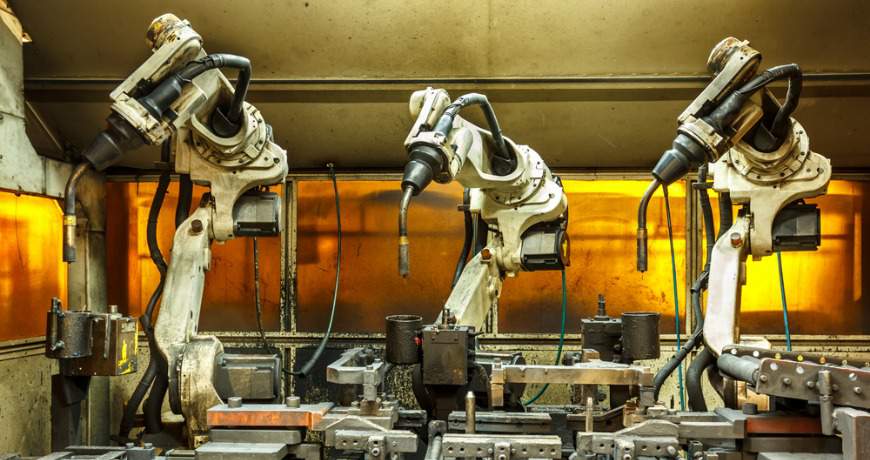Automating production is all the rage these days. What is the purpose of removing human involvement from a process? It turns out, it can help a manufacturer save serious money.
CMC's lean manufacturing experts have gathered 4 ways an automated production system can cut costs for manufacturers in this blog post...

Let's now take a closer look at 4 of the major benefits that manufacturers can gain from production automation:
1. Save on production operators’ wages
In 1995, the attitude in Chinese factories was “labor is virtually free, so we should focus all our energy on not wasting materials and we should only buy machines for jobs operators can’t do.” With wages going up 15-20% a year, the situation has changed. Labor is now cheaper in Mexico, Rumania, Vietnam, and India, than in China.
These days, manufacturing managers are looking for opportunities to replace labor by equipment. The main constraint is the lack of cash to buy that equipment – otherwise automation would be a much stronger phenomenon.
Let’s take an example. A machine can replace 11 operators, and costs 2,000,000 rmb to buy. Running it will cost 100,000 rmb a year in electricity.
The 11 operators cost 500,500 rmb a year in salary, social insurance, etc. (3,500 rmb x 11 people x 13 months) and their cost is growing at 12% a year.
Over the expected machine lifetime of 10 years, the cost difference is pretty large – 3,000,000 RMB for the machine vs. more than 6,000,000 RMB for the operators.
Note a few extra savings:
- If a sequence of processes is automated, some logistics operators are made redundant;
- If the new equipment can transfer key data directly into the company’s ERP system, there is no need for manual notes & input.
2. Save on management overhead
The fully-loaded cost of employing people is not only their wages. Here are a few ‘hidden costs’ that many managers overlook.
Replacing an operator consists of finding and hiring a replacement, training the new hire, lost production, and lower quality. Many companies have studied this and concluded the cost is about 25% of the annual salary.
To get back to our example, let’s say that 7 of the 11 operators have to be replaced every year (this is typical in China). The related cost amounts to 25% x (7 x 13 x 3,500) = 79,625 RMB a year.
Supervising those people on a day-to-day basis is another expense. Let’s say a group leader is paid 6,000 RMB a month to manage these 11 workers. And a supervisor, who is paid 12,000 RMB a month, spends 20% of his time managing this group. All these costs add up!
3. Reduce the costs of poor quality
In highly manual operations, and in the absence of proper training and mistake proofing, many quality issues are caused by operators. Here are a few examples:
- The two halves of a remote control’s casing are assembled, but a gap subsists between them
- The wrong wires are soldered in an electrical product
- Metal parts get scratched because they are not sufficiently “packaged” when transported from one process to the next
- The upper of a shoe is not properly sewn and breaks easily
As a result, an average of 30% of people are busy re-working in some factories. It sounds quite high, but it is not readily apparent. Only when you start to count who does what, does the problem become obvious.
Other costs of poor quality include customer claims, scrapped material, expedited shipments, and an unnecessarily high number of inspectors.
What about the alternative, a well-setup and well-maintained piece of automated equipment, which detects its own issues and stops immediately when needed? It can be expected to deliver much more consistent quality.
4. More targeted sales & marketing efforts
Given the cost and quality benefits of a well-oiled automated production system, some customers are looking specifically for manufacturers that have automated their processes.
If that’s your case, you can target bigger companies, have something interesting and potentially unique to say, and enjoy shorter sales cycles. Hopefully you can say good bye to “spray and pray” marketing channels such as Alibaba and trade shows.
All in all, robots and other automated equipment hold significant promises. Calculations of return on investment are often very clear, with payback periods sometimes under 3 years.
What do you think about automated production systems?
Have you studied the opportunity to automate some processes? What reactions did you get from the production supervisors? How has your experience been?
Please let our community know, and of course ask any questions you may have about automation and manufacturing in general by leaving a comment below...


!["Will You Save Money With Process Automation in Your Factory" [PPT + sheet]](https://no-cache.hubspot.com/cta/default/2185827/52f5b8e3-df93-462a-8296-294ae6cee133.png)

